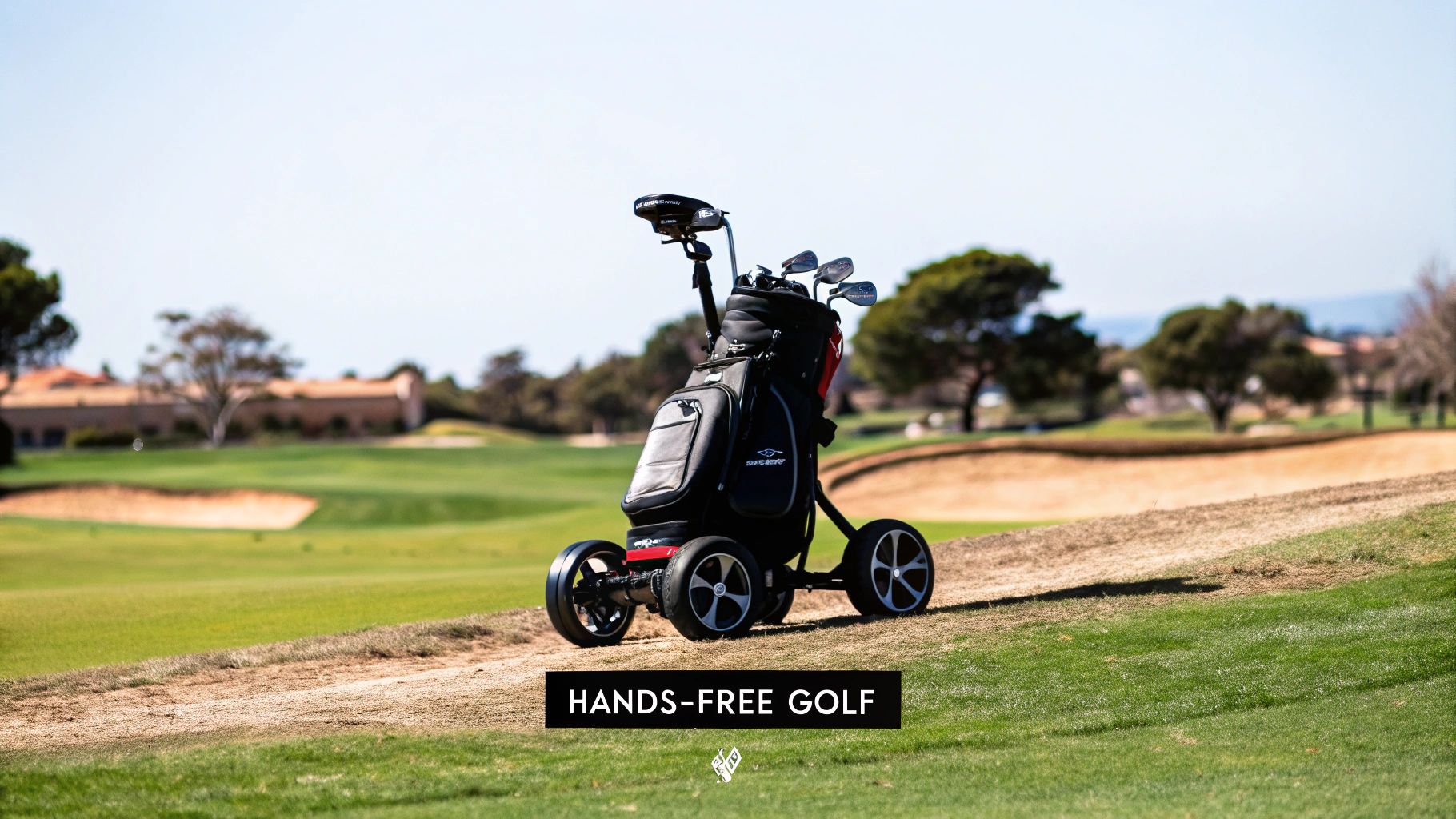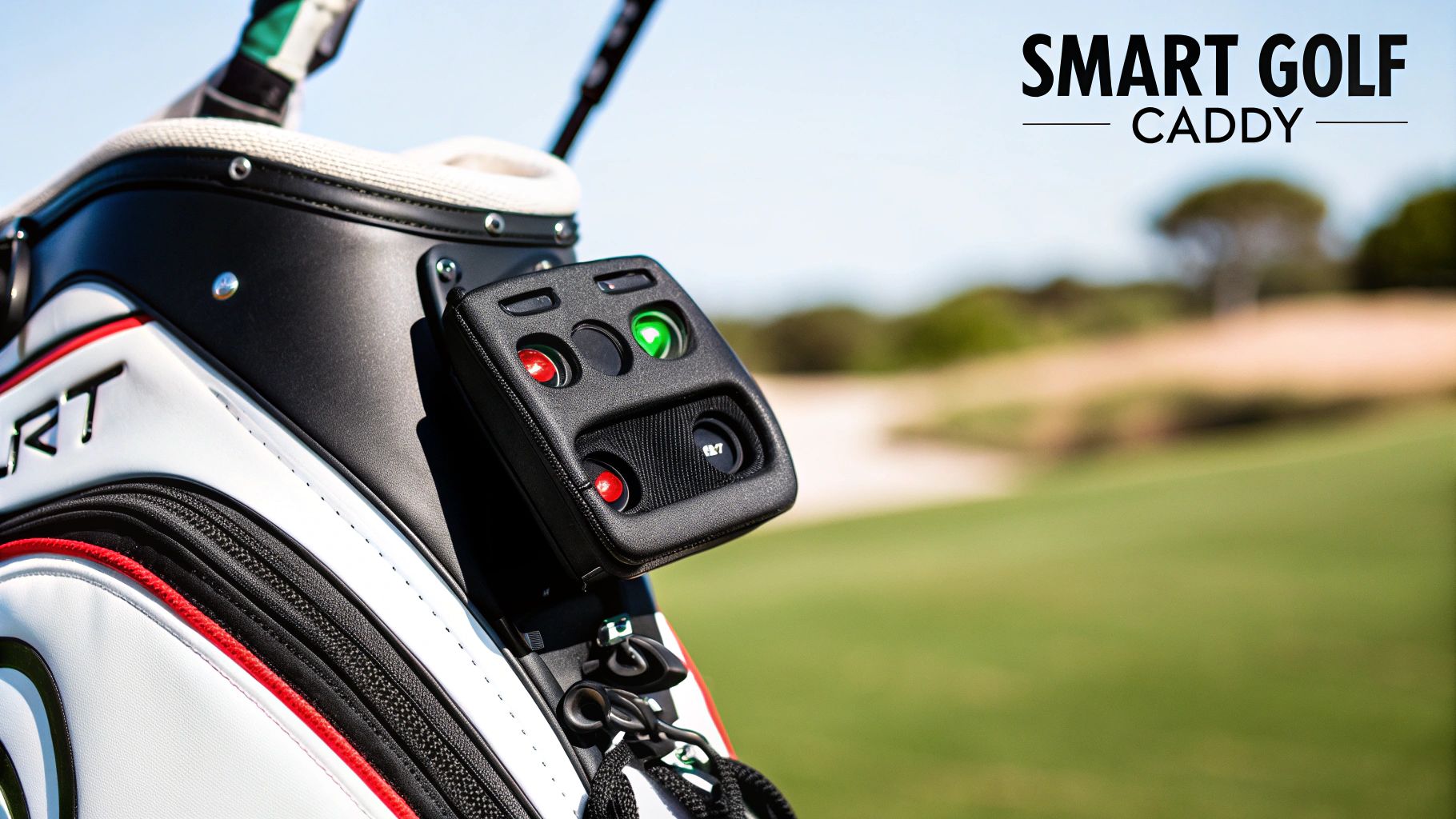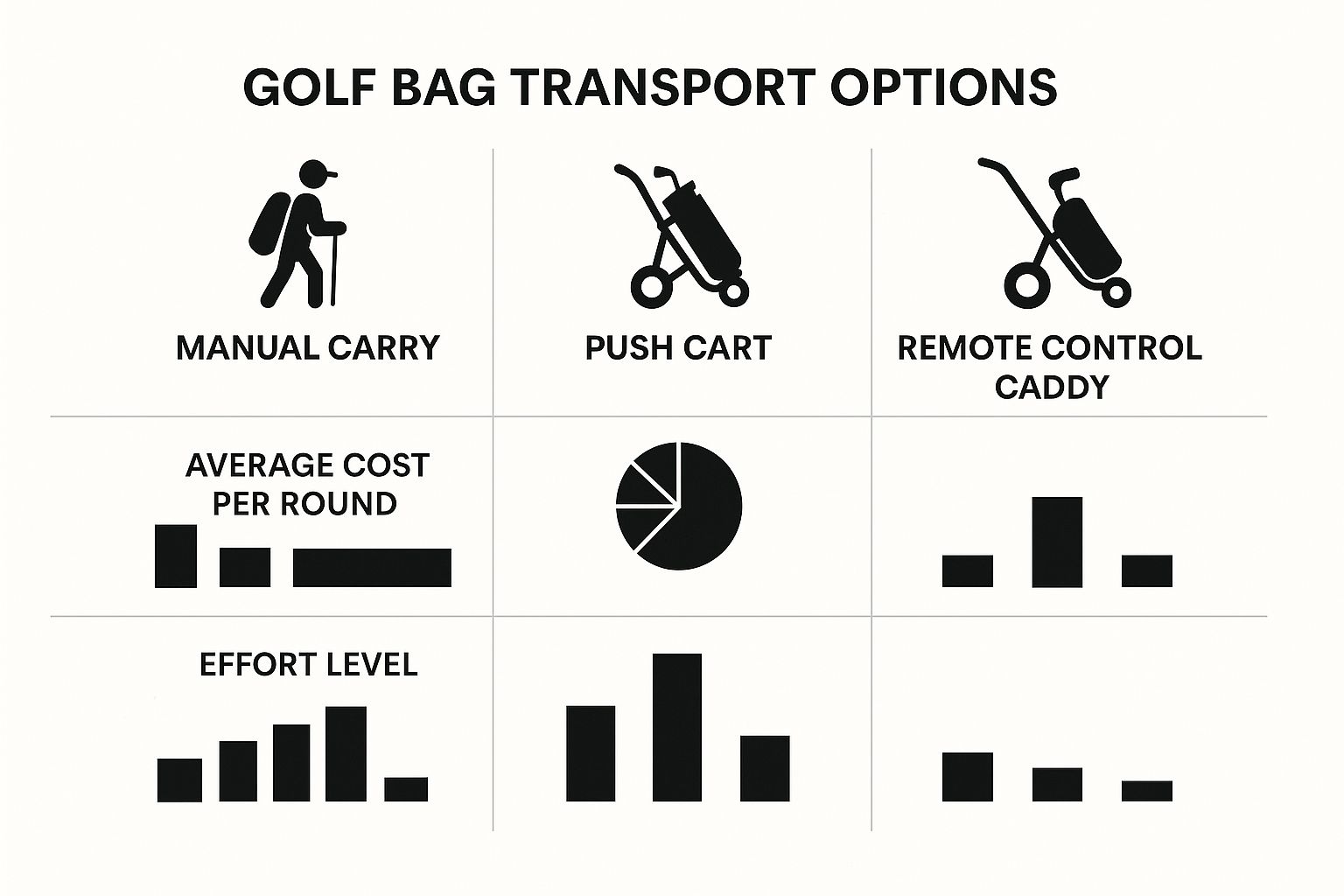A golf bag remote control is a simple but brilliant piece of tech that turns your regular push cart into your own personal, self-propelled caddy. It lets you walk the course completely hands-free, with your bag either following behind you or heading to the next spot on your command. It's a huge leap in convenience that frees up both your physical and mental energy for the game itself.
The Smarter Way to Walk the Course

Picture this: you're gliding through 18 holes, and your mind is entirely on your next shot—not on the strain of wrestling a heavy bag up another hill. This is the new reality that a remote-controlled system offers. It's about more than just carrying your clubs; it's about actively improving your entire on-course experience.
Think of it like swapping a manual car for an automatic. The core function is the same, but the ease and efficiency are worlds apart. By taking the physical tax of managing your equipment off your shoulders, you can save that precious energy for what really matters: your swing.
A Growing Trend in Golf
This move toward hands-free convenience isn't just a niche idea; it’s part of a much bigger shift in the golf world. More and more players are recognizing the health benefits of walking the course but are looking for ways to ditch the fatigue that can ruin their performance on the back nine. This demand is fueling some serious market growth.
The golf trolley market, which includes these remote systems, was valued at over $142 million recently. Projections show it climbing to nearly $250 million, driven by new tech like remote control and GPS features that directly answer the call from golfers for more convenience.
This technology helps you walk off the 18th green feeling as fresh as you did on the first tee. It turns a long, tiring walk into a real strategic advantage. It's not about being lazy—it’s about playing smarter.
From Burden to Advantage
The benefits of a golf bag remote control go way beyond just saving a bit of energy. When you automate the movement of your bag, you can:
- Maintain Your Focus: Keep your mind on reading the green and selecting your next club, not on steering your cart around a bunker.
- Improve Pace of Play: Send your bag ahead to the next tee box while you're still putting out. This keeps the game flowing smoothly for everyone.
- Reduce Physical Strain: Take the stress off your back, shoulders, and knees. This is a game-changer on hilly or particularly long courses.
This simple upgrade transforms your golf bag from a heavy burden into an active assistant on the course. You're no longer just a player; you're the commander of your own personal caddy. You can discover more insights about this growing market on market.us.
How Remote Control Golf Caddies Work
To really appreciate the magic of a hands-free round, it helps to peek under the hood. A modern golf bag remote control system isn't just a motor strapped to a frame; it’s a smart, coordinated system where every part works together to give you effortless command over your gear.
Think of it like a specialized, high-end remote control vehicle. But instead of being built for speed or stunts, it’s engineered for one thing: navigating a golf course with quiet precision and total reliability. At its core, the system relies on a few key components to turn your simple button presses into smooth, dependable motion across the fairways.
The Brains and Brawn of the System
The whole operation kicks off with the remote in your hand. When you press "forward," "left," or "right," the remote sends a low-frequency radio signal to a receiver tucked away in the caddy’s chassis. This receiver is the brains of the operation, instantly interpreting your command and telling the battery where to send power.
At its core, a remote caddy operates on a simple principle: Signal > Receiver > Action. The remote sends the signal, the receiver unit interprets it, and the motors and braking system take action, all in a fraction of a second.
This seamless communication is what lets you guide your bag with incredible accuracy, whether you're sending it 50 yards down the fairway or making a tight turn around a greenside bunker.
The real workhorses are the dual motors. These aren't loud, clunky engines; they're whisper-quiet electric motors designed for torque and control, not just raw speed. When the receiver tells them to turn, one motor might slow down or even reverse slightly while the other maintains speed, allowing for an incredibly tight and stable turning radius.
To give you a clearer picture of how these parts work together, here’s a quick breakdown:
Core Components of a Remote Control Golf Caddy
| Component | Primary Function | Key Consideration |
|---|---|---|
| Handheld Remote | Transmits user commands (forward, reverse, turn, stop) via radio frequency. | Look for an ergonomic design with intuitive, easy-to-press buttons and a reliable signal range. |
| Receiver Unit | Acts as the "brain," receiving signals from the remote and sending instructions to the motors and brakes. | A quality receiver ensures a fast, lag-free response to your commands. |
| Dual Electric Motors | Provide the power and control to move the wheels. They work independently for precise steering. | Quiet operation and sufficient torque for hills are crucial for on-course performance. |
| Lithium-Ion Battery | Powers the entire system, from the receiver to the motors. | A high-capacity battery is essential. It should be powerful enough for 18 to 36 holes but still lightweight. |
All this power comes from a high-capacity lithium-ion battery—a lightweight powerhouse strong enough to last a full 18 or even 36 holes on a single charge. This trio—remote, receiver, and motors—is the foundation of any quality golf bag remote control system, turning your cart into a truly dependable partner on the course.
Essential Features of a Modern Remote Caddy

Not all remote systems are created equal. While the basic job of moving your golf bag is a given, it’s the specific features that separate a good golf bag remote control from a great one. Understanding these functions helps you find a system that actually improves your game instead of just being a fun novelty.
Think of the foundational features as the non-negotiables—the basics of driving a car. They have to be intuitive and completely reliable.
- Variable Speed Control: The ability to dial in the caddy's pace to perfectly match your walking speed is crucial for a smooth round.
- Responsive Steering: You need instant, dependable turning to navigate those tight spots around bunkers, cart paths, and trees.
- Electronic Braking: This is a must-have safety feature, especially on hilly courses. It ensures your caddy stops the second you command it to and doesn't decide to take a solo trip down an incline.
Once you have those basics covered, you can start looking at the advanced functions that take the experience from simple remote steering to true, hands-free automation.
Game-Changing Advanced Functions
This is where modern caddies really start to shine. The best features are the ones designed to minimize how often you even have to touch the remote. These smart functions let you keep your head in the game and your hands free for your scorecard or rangefinder.
One of the most popular is Follow Mode, which uses sensors to have the caddy trail you automatically at a set distance. Another powerful tool is the Automatic Distance Function (ADF). With a single button press, you can send your cart a pre-set distance ahead—say, 50 yards down the fairway or straight to the next tee box—while you finish up on the green.
The most significant advancements are those that reduce physical and mental effort. Features like automatic distance and follow modes directly address this, allowing a player to focus entirely on strategy and shot execution, not equipment logistics.
This evolution in features is a key reason the electric golf caddy market is booming. Valued at around USD 1.2 billion, it's projected to more than double to USD 2.5 billion, driven largely by the rapid adoption of remote control, GPS, and smartphone integration.
Choosing the right features really comes down to your personal play style and the courses you frequent. For an in-depth look at how these functions stack up across different models, check out our guide to the best remote control golf trolley models and tips.
The Real-World Benefits of a Hands-Free Golf Game
So, what does using a remote caddy actually feel like out on the course? Forget the tech specs for a moment. The real magic is in how it completely changes your round, shifting your energy—both physical and mental—away from manual labor and squarely back onto the game.
Picture this: you're a golfer who used to dread hilly courses. You’d feel your energy drain with every uphill pull, and your back would start aching around the 12th hole. Now, with a golf bag remote control, those same hills just become part of the scenery. You can walk the course with a spring in your step, sending your bag ahead while you conserve precious stamina for powerful, precise shots—especially on that critical back nine.
More Focus, Less Fatigue
The most immediate and obvious benefit is the massive reduction in physical strain. A fully loaded golf bag can easily weigh 30 pounds or more. Pushing or pulling that kind of weight over five miles of uneven ground puts a serious tax on your back, shoulders, and legs. Getting rid of that burden doesn't just prevent next-day soreness; it leaves you with more endurance to maintain your swing mechanics from the first tee to the final putt.
That physical relief translates directly into mental clarity. Instead of constantly calculating the easiest path for a heavy cart, your mind is free to lock in on what truly matters:
- Reading the subtle break of the green.
- Thinking through wind direction and club selection.
- Visualizing your next shot with a clear head.
This shift in focus is a huge reason behind the explosive growth in the electric golf caddy market. More and more players are realizing these exact benefits.
The market's projected climb just goes to show how many golfers are investing in technology that helps them cut down on fatigue and sharpen their focus.
By removing the constant, low-level distraction of managing your bag, you can get into a much more strategic headspace. It’s no longer about just getting your gear from point A to point B; it’s about playing chess with the course.
All that saved energy also does wonders for your pace of play. While your partners are busy wrangling their bags, you can send yours on ahead to the next tee, so it’s waiting for you when you get there. A remote caddy doesn’t just make the game easier—it helps make you a more focused, strategic, and efficient golfer.
Choosing the Right Remote Caddy for You
Alright, you've seen what these remote systems can do. Now comes the fun part: deciding which type of golf bag remote control is right for your game. It really boils down to two main paths: buying a brand new, all-in-one integrated remote trolley, or upgrading the push cart you already have with a conversion kit.
Each route has its own pros and cons, and the best choice really depends on your budget, what gear you currently use, and what you need out on the course.
An integrated trolley is a complete package, built from scratch for remote operation. They often have all the bells and whistles but come with a premium price tag. On the other side, a conversion kit like the Caddie Wheel is a clever solution that adds motorized, remote-controlled power to the trusty push cart you already know and love. This makes it a much more affordable and flexible way to get into hands-free golf.
This image really puts the cost and effort of different on-course transport methods into perspective.

As you can see, while a remote caddy requires a bigger initial investment, the physical effort it saves you round after round is massive compared to carrying or pushing.
Integrated Trolley vs. Conversion Kit
So, how do you pick between the two? Think of it like this: an integrated model is like buying a new car with all the latest tech factory-installed. It's seamless, but you're paying for the entire vehicle. A conversion kit, on the other hand, is like adding a powerful, high-tech engine to a car you already own and trust. You get a huge performance boost without having to replace something that already works great for you.
The best choice depends entirely on your starting point. If you don't own a quality push cart, an integrated system makes a lot of sense. But for the vast majority of golfers who already have a cart they like, a conversion kit offers incredible value and performance.
To make the decision crystal clear, let's put them side-by-side.
Integrated Remote Trolley vs. Conversion Kit
This table breaks down the key differences to help you figure out which option aligns best with your needs and budget.
| Feature | Integrated Remote Trolley | Conversion Kit (e.g., Caddie Wheel) |
|---|---|---|
| Initial Cost | Higher, often $1,500+ | Lower, typically under $800 |
| Ease of Transport | Can be bulky and heavy to lift | Lightweight and detaches for easy transport |
| Setup | Ready out of the box | Quick, tool-free installation on your existing cart |
| Flexibility | Limited to one dedicated unit | Can be removed to use your cart manually |
When you look at it this way, it's clear why a conversion kit is such a practical, powerful, and budget-friendly path to a hands-free game for most golfers. It gives you all the benefits without forcing you to start from scratch.
For an even deeper dive into making the right choice, our modern golfer's remote golf push cart guide has more great tips and insights.
Common Questions About Remote Control Caddies

Jumping into new golf technology is always exciting, but it’s smart to have a few questions before you commit. When it comes to a golf bag remote control system, most golfers find themselves wondering about the same practical, on-the-course details. We've heard them all, and we've gathered the most common ones here to give you clear, straightforward answers.
Our goal is to put to rest any doubts you might have about making the switch to a hands-free game. Let's tackle the big three: battery life, ease of use, and what happens if something goes wrong mid-round.
How Long Does the Battery Last?
This is usually the first question out of every golfer's mouth, and for good reason—nobody wants their caddy giving up on them at the 14th hole. The good news is that modern remote systems are built for serious endurance. Most run on powerful but lightweight lithium-ion batteries, designed specifically to last a full round and then some.
- Standard Performance: A quality battery will comfortably power you through at least 18 holes on a single charge.
- Premium Models: Many systems, including the Caddie Wheel, are engineered to last for 27 or even 36 holes.
Of course, factors like a super hilly course or an extra-heavy bag can influence the total runtime, but if you give it a full charge before your round, you’ll have more than enough juice.
A dead caddy is a legitimate concern, but manufacturers have poured a ton of engineering into battery reliability. The key is simple: treat it like your phone and give it a full charge before heading to the course.
Are They Difficult to Use?
Not at all. The best systems are designed with simplicity as a top priority. An integrated trolley is usually good to go right out of the box. Meanwhile, a conversion kit like the Caddie Wheel has an intuitive, tool-free installation that takes just a few minutes.
The remotes are ergonomic, with clearly labeled buttons that are easy to master after just a few minutes of practice. Seriously, if you can use a TV remote, you can handle a remote caddy.
So, what happens if the remote's battery dies or it loses connection? While it's a rare event, there are built-in failsafes. The cart will automatically brake to stop a runaway situation. More importantly, every remote system can be switched into "freewheel mode," letting you push it just like a standard cart to finish your round without missing a beat.
For a deeper dive into the different options out there, you can explore our guide to help you discover the best remote golf caddy for your game.


Share:
Calorie Burn Playing Golf Your Ultimate Guide
The Ultimate 2025 Golf Buggy That Follows You: 7 Top Models